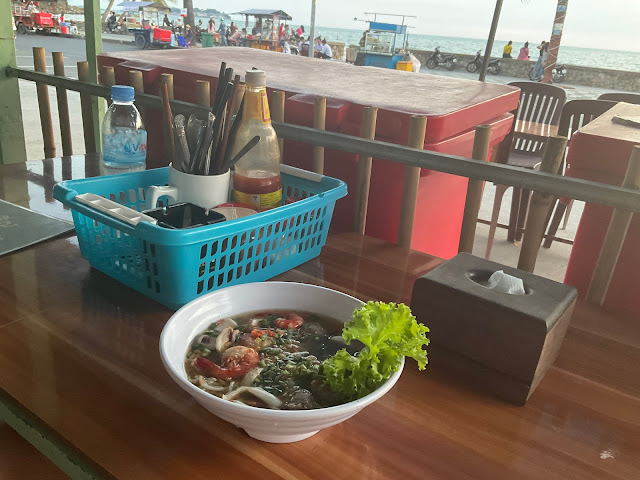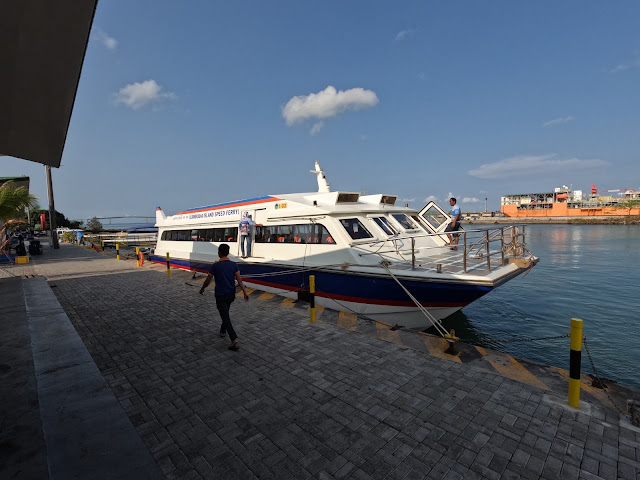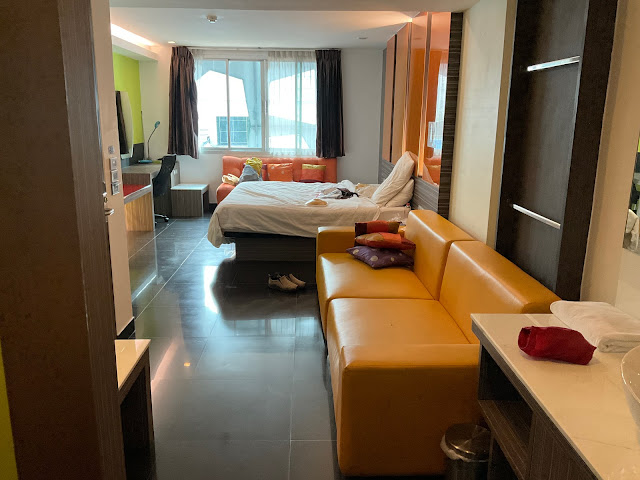SAD 😢
Over 1,000 abandoned Chinese buildings and casinos fill the Sihanoukville skyline.
Departing Thailand was pretty straightforward since the official merely stamped my passport with a departure stamp over the entry stamp. The German, who was on a passport run, and I then proceeded to the Cambodian Immigration office.
The Cambodia Crossing is always interesting because you never know how much extra you’re going to pay for “expedited service“. The official asked me to pay ฿1,600–USD 45. The official fee is $30 plus a $7 service fee. The bribe ended up being about USD 8. It’s funny, how so many countries never accept their own currency as payment for their visas.
The official then proceeded to fill out my immigration Visa form, as well as took the photo I provided to him and stuck it in a drawer.
Once one officer filled out the form and collected my money, the second officer pulled out his rubber stamp and wielded his rubber stamp about ten times on various forms and documents, including my passport and visa form that they stapled in my passport. There were another three officers in the interview room who appeared to be observers—-or verifying the bribe amount.
I thought I was done when I left the interview room, but then I was instructed to go to another window and hand over my passport with the well-stamped visa forms. This window had a fingerprint reader, but the official didn’t use it. He just did something with my passport and then gave it back to me after 5 minutes. The German finished about the same time, and he headed back to Thailand with his Thai guide. I thanked them both for the ride to the border.
Here in Cambodia, the currency is both the US dollar and the Cambodian rial. The ATMs offer both currencies. For larger purchases, you pay in US dollars and you usually get change in Cambodian rials. It is about 4,000 Cambodian reels to one US dollar.
As soon as I got my passport, a fellow came up to me and asked me if I needed a ride somewhere. I told him Koh Kong—the first Cambodian city from the border and about 9 miles away. He charged me USD 6 for the 1/2 hour motorbike ride to my hotel—not my favorite mode of transportation.
As I checked into the Apex Kong hotel, the clerk asked me where I was headed next, and I said to Sihanoukville. He said that the bus was $17 and he could arrange for a shared taxi for $20 so I told him to arrange for the taxi for the 5-hour drive.
I paid $22 for a night at this hotel, which had a swimming pool near my room. As soon as I dropped off my bags I put on my swimsuit and enjoyed the refreshing swim in the pool after a long travel day from Koh Kood.
As I headed toward the waterfront, I didn’t see any restaurants until right along the waterfront area and I saw no tourists, just local Cambodians.
I had this dinner at this corner restaurant and fortunately, they had a picture menu so I pointed to what looked like bok choy and shrimp. I also ordered orange juice and I ended up with Fanta. I guess I was eating early because the place was empty except for one other group. Cambodians most likely come around for dinner after dark when it cools off.
After breakfast at the hotel, the SUV taxi showed up and I joined a mother with two small girls and a woman for the 5-hour drive to Sihanoukville.
Most of the road was under construction and we spent a lot of time driving on temporary dirt roads next to the construction of a 4-lane freeway. It was a bumpy and dusty drive.
We stopped here for some snacks and a bathroom break.
As we approached Sihanoukville, I was shocked to see how much it had changed since I was last there in 2016.
Down near the Oteros and Serendipity Beach areas, the popular backpacker bungalows along the beach area and the 2 to 3-story guesthouses had been torn down and in their places were Chinese-owned high rises, casinos, Chinese restaurants, and abandoned partially completed buildings.
The sea of sun lounge chairs and umbrellas that used to be all along the Oteros and Serendipity Beach areas in 2016 were gone when I was last here. The Chinese business owners of the many Chinese restaurants that had replaced the bungalows required the city to remove all lounge chairs. In its place were empty Chinese restaurants all day with no one on the white sand beach areas until you got past the Chinese business area. I was so sad by what was no more, but at least a good memory.
Serendipity Beach area in 2016
Serendipity Beach area in 2024
Among the palm trees past Serendipity Beach, the Cambodians were allowed to use the beach but only with temporary small chairs and tables. As evening approached, this beach area was filled with families who were cooking up their evening meals and visiting with each other.
I had dinner along the Cambodian portion of the beach area that catered to Cambodians and not Western tourists. I pointed to a soup dish that another customer was eating and ordered that. It was a very tasty seafood soup. As I had dinner, I watched the sunset across the street from the restaurant.
With the downturn of the Chinese economy, there were now over 1,000 abandoned high-rise and other buildings throughout Sihanoukville. The Cambodian government has no way of doing anything about these deteriorating buildings other than to watch them crumble away.
It is as though these Chinese businesses came in and raped Cambodia for their own pleasures with gambling at the top of the list, and tore away its fragile soul that was recovering from its genocidal past.
I first stayed in the Oteros Beach area which was an exciting place to be back in 2016, with all of its backpacker guesthouses and restaurants now it was just an empty beach area only filled up temporarily and night as Cambodian families appeared with BBQs, small tables and chair to eat, mix and mingle with other families.
Now thinking about it, perhaps what I experienced back in 2016 was something that backpackers and travelers imposed on Cambodians although less intrusive than what the Chinese businesses are now doing.
For Cambodia, I think there are possibilities of better things to come when I recall my last visit to Cambodia in 2016 when I visited a Room to Read charity project near Phnom Penh that focused on the education of children, especially girls. Here is the link to my experiences back then.
2016 Promising Cambodian Future
After two nights at the Otero Beach Boutique, I moved closer to Serendipity Beach and the pier and stayed at the Koh Pos Guesthouse for another 2 nights.
When the Tuk-tuk dropped me off, I noticed that most of the buildings had their generators running since the electricity was out, and I saw the workers trying to repair them. It took about 7 hours for the repair.
During the day, I walked along the empty beaches and saw the staff of all of these empty Chinese restaurants just waiting for the few daytime customers and working their cellphones.
Through the hotel, I booked a round-trip boat out to Koh Rong Island for $25. Instead of leaving the pier on Serendipity Beach like I had done in 2016, I was driven about 1/2 hour for $5 to the new pier area where several boat companies were loading up customers.
My 9 AM catamaran boat dropped me off at the Long Set Beach where I had breakfast before heading to Long Beach.
After walking about an hour to get to Long Beach, I got tuk-tuk rides both to and from Long Beach for $7. Well worth it considering the heat.
Long Beach with its white sand beach was still fairly undeveloped. One of the reasons I came to this island was that an episode of the reality show “Survivor” was filmed here.
I enjoyed seeing this beach again but was glad I decided to stay in Koh Rong just for the day.
Instead of continuing on to other parts of Cambodia, I decided to return back to Thailand. A travel company had advertised a bus that would take me to Ko Samet, but that had been canceled so I ended up booking a bus ride all the way back to Bangkok for $43. It was a 12-hour journey including going back to the same Cambodia/Thailand crossing on the rough road with a bus change at the border.
At night, all of the Chinese buildings, hotels, and casinos were lit up for a light show similar to what I had seen in China. As I looked at these gaudy buildings, I wondered if the earlier electrical outage was frequent, and whether these excessive light shows contributed to the frequent outages.
When my shuttle bus got to the bus station, I ended up getting on a comfortable minibus at 9 AM. It would take us to the Hat Lek border where we would transfer to other minibuses to complete our journey to Bangkok or other places in Thailand.
After a 2-hour drive, we pulled into a rest and restaurant area. I didn’t have any Cambodian rial so I offered the cook a dollar for whatever she could sell to me for breakfast.
For a dollar, I got this delicious soup filled with green vegetables and some meatballs and pieces of meat along with a iced green tea.
It was then back onto the bumpy road that ran alongside the big construction project that would create a four-lane highway from the border to Sihanoukville.
At the border, the Cambodian officials merely pulled out my well-stamped Cambodian visa from my passport and sent me over to the Thai immigration offices. We first filled out immigration forms and then passed through their immigration offices after having our pictures and fingerprints taken.
They stapled our immigration forms to our passports. I now had a 30-day visa. Before COVID-19, you only got a 15-day visa when traveling to Thailand by land and 30 days if traveling by air. I suppose this extension of visa time was done to encourage more tourism which was devastated by the pandemic. Stephen, from Germany, was ahead of me and also going to Bangkok.
Our original travel group got split up since several were heading to Trat and Ko Chang Island I and others were heading to Bangkok.
We continued on to Bangkok and were dropped off about a quarter mile from the Phaya Thai Skytrain station. From there, Stephen, from Germany, and I walked to the station using Google Maps to guide us. I showed him how to get tickets and travel on the Skytrain since he had never been to Bangkok before.
After a long travel day, I was glad to get to my Heaven@4 hotel for a welcomed, hot shower and comfortable bed for $33 per night.
After two days here, I took the bus and ferry boat for ฿240 to Ko Samet Island, where I stayed for a week and a half relaxing on my favorite island. The new large bus to Ban Phe took about three hours, and the ferry boat took half an hour to get to my island paradise.
Subscribe to my YouTube Channel
I have recently uploaded all of my travel videos to YouTube now that they allow longer uploads. I have also added other shorter travel videos.
That link is https://www.youtube.com/c/huntforgold
If you do go there, please subscribe to my video channel since it will help me eventually get some income there and help with my future travels.
























































No comments:
Post a Comment